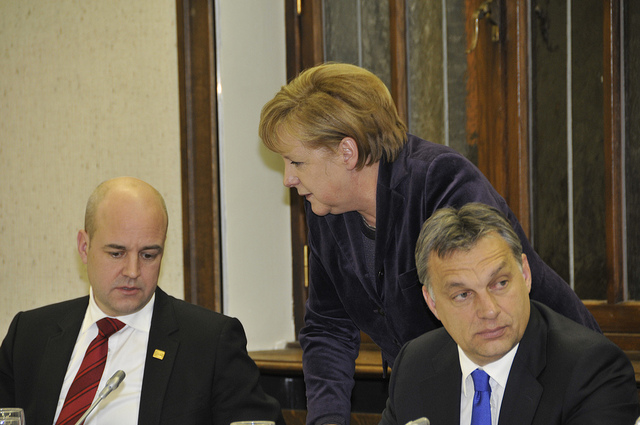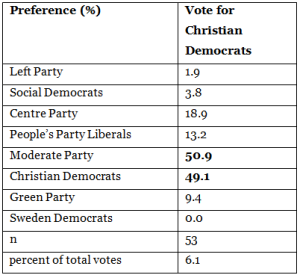Parties’ pre-election signals can and do influence strategic voting, according to evidence from Sweden
Britain is entering what appears to be a period of multi-party politics, with the old two party system seemingly disintegrating before our eyes. In this context, tactical voting takes on added importance, with numerous members of the electorate willing to ‘hold their nose’ and vote for a party they do not favour in order to keep a less favoured party out. Annika Fredén here presents research which shows that the messages sent by parties about their post-election intentions can and do influence strategic voter choice, with implications for electoral outcomes.

Are Frank Reinfeldt and Angela Merkel discussing tactical voting? (Credit: European People’s Party, CC BY 2.0)
Just before the 2010 Swedish General election Prime Minister Fredrik Reinfeldt called voters to elect a centre-right “Alliance” to deliver a stable government. In this election, a large part of his own Moderate Party’s supporters chose to vote for the smaller coalition member, the Christian Democrats. In the most recent general election in Germany, on the other hand, the two right-wing government parties ran separate campaigns and the small liberal party the FDP unexpectedly fell below the electoral threshold. In Sweden 2010 there were two clear pre-electoral coalitions, whereas in Germany 2013 the coalition signals were weaker. These contextual factors are likely to influence the decision to vote for a small party. In this post I take a closer look at the relationship between coalition signals and strategic voting for small parties.
Different types of strategic voting
Strategic voting is usually defined as voting for some other party than one’s most preferred one, motivated by the intention to affect the outcome of the election. It is most straight-forward in first-past-the-post systems, such as Britain, where voters who prefer a small party may abandon it for some other party that is more likely to gain a seat. In proportional representation systems (PR) a larger number of parties are represented and governments tend to consist of a coalition of parties. Even under PR voters may cast strategic vote for large parties, since these have greater chances of gaining influence and holding the position as Prime Minister.
There are also incentives cast a strategic votes for small members of a potential coalition. In most PR systems there is an electoral threshold of the minimum share of votes a party must receive to get elected, making votes for small parties potentially more influential on the distribution of seats than voting for a larger party. The presence of the small party in parliament may even make the difference between winning and losing the election as a coalition. The signals that the parties send out about whom they cooperate with should affect this kind of strategic voting for small parties, sometimes referred to as “threshold insurance voting”. If some parties explicitly announce that they intend to form a coalition if they would win, supporters of the larger parties should be more likely to defect to a smaller partner.
Evidence from Sweden
Some recent research finds that insurance voting has taken place in, for example Germany, Austria, and Sweden. One recent example is the 2010 national election in Sweden, in which the pre-electoral coalitions were very clear: the parties to the left competed with the incumbent four-party centre-right coalition. Before the election, the polls showed that the Christian Democratic party, a social-conservative party in the centre-right Alliance, was the party most at risk of falling below the threshold. Analyses based on the Swedish national election study show that among those who voted for the small Christian Democrats, a majority actually had the bigger Moderates as their preferred party (Table 1).
Table 1: Party preference and voting Christian Democrats
Note: Pre-election preference based on the voter’s highest score on 11-point sympathy scale (including ties) and self-reported vote choice, 2010 Swedish National Election Study
Thus, in this election many supporters of the biggest right-wing party chose to cast a vote for a smaller coalition member. Controlling for other factors that affect choice, such as party identification and position on a political left-right scale in a multivariate model, there is still a significant impact of threshold insurance motives on voting for the Christian Democrats.
In contrast, in the 2013 German national election, the incumbent centre-right coalition the Christian Democrats (CDU) and the liberal FDP ran separate campaigns. Whereas the FDP in previous election had gotten strategic votes from CDU-supporters, this time the FDP fell below the 5 percent threshold. Moving on to the Swedish general election in September 2014, there were two small parties at risk of not reaching the four percent electoral threshold: the Christian Democrats and the outsider Feminist Initiative on the left side. In this election, the coalition signals from the leading left party the Social Democrats were ambiguous, and Feminist Initiative fell short of the threshold, whereas the Christian Democrats were elected again.
Conclusion
The overall findings are that coalition signals and polls do matter for strategic voting for small parties under PR. Coalition negotiations before an election gives a party credibility and the likelihood that it gains influence increases. Considerations of coalitions are becoming more relevant also for first-past-the post system such as Britain, when party identification decreases and there are a larger number of alternatives than before.
—
Note: this post represents the views of the author, and not those of Democratic Audit, the LSE. Please read our comments policy before posting.
—
 Annika Fredén is a PhD Candidate in the Department of Political Science at Lund University in Sweden, specializing in strategic voting behaviour and experimental methods. Her personal website can be found here.
Annika Fredén is a PhD Candidate in the Department of Political Science at Lund University in Sweden, specializing in strategic voting behaviour and experimental methods. Her personal website can be found here.






 Democratic Audit's core funding is provided by the Joseph Rowntree Charitable Trust. Additional funding is provided by the London School of Economics.
Democratic Audit's core funding is provided by the Joseph Rowntree Charitable Trust. Additional funding is provided by the London School of Economics.
Parties’ pre-election signals can and do influence strategic voting, according to evidence from Sweden https://t.co/J1MBeyO4qy
Parties’ pre-election signals can and do influence strategic voting, according to evidence from Sweden https://t.co/5htTExzpFn
Parties’ Pre-election signals can and do influence strategic voting, according to evidence fr… https://t.co/xXSRAnoj9T https://t.co/Z91Jt4Kpj8
Parties’ Pre-election signals can and do influence strategic voting, according to evidence from Sweden https://t.co/Rj1SQQ7c3u
Parties’ Pre-election signals can and do influence strategic voting, according to evidence from Sweden https://t.co/wr61AvWMmF